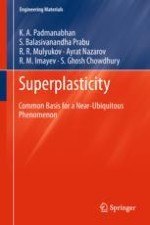This book combines the perspectives of materials science of Superplasticity, on the one hand, and those of design and mechanics, on the other, in order to provide a holistic view of materials, design, mechanics and performance which will lead to useful solutions of societal benefits, in addition to providing great intellectual challenges. After considering the experimental evidence for superplasticity in different classes of materials, the book discusses the physics-based models, along with their advantages and limitations. Then, the analyses for superplastic forming available in the framework of continuum mechanics, finite element analysis and numerical simulations are presented. Finally, the authors highlight some successful industrial applications.
This book is recommended as a text book for courses on Superplasticity and as supplementary use for courses on Materials Processing, Manufacturing, High Temperature Deformation, Nanotechnology and Mechanical Behavior of Materials. Persons working in Department of Materials Science and Engineering, Physics, Mechanics, Mechanical Engineering, Aerospace Engineering, Metallurgy, Ceramics and Geo-sciences are likely to find the book to be useful. It is also recommended as a reference source for practicing engineers involved in the design, processing and manufacture of industrial components, which exploit the unique properties associated with superplastic materials.
